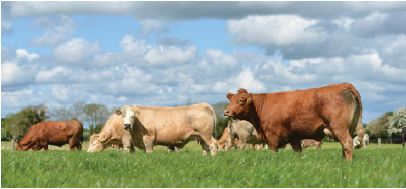



Extending Your Grazing Rotation In Late Summer
Many beef farms can build up pasture from August to get more from the grass they have, Irish farmers have been advised.Grazing rotations take planning and should be expanding to around 35 days by mid-September from 18 to 22 days in early August, say experts at the Irish Food and Agriculture Development Authority.
Teagasc staff write that, in August, average grass growth rates per day are usually still above the daily demand for grass and this allows you to increase your rotation length, whereas this may not be the case in September when it will be too late to have much of an impact.
From August 10 onwards, start increasing the covers of grass that you are targeting to graze. Instead of aiming to be grazing 1,300 to 1600kg DM per ha (9- 10cm), gradually move towards pre-grazing covers of 2,000 to 2,300 (12-13cm).
Covers above 2,500kg DM per ha (14cm) should still be taken out as surplus round bales. However, avoid removing paddocks from late August onwards as they will not have enough time to grow a worthwhile amount of grass to contribute towards the last rotation. Continue to graze out swards tightly with suckler cows (avoid forcing growing weanlings/cattle to stay too long in a paddock).

Autumn Fertilser
The amount of nitrogen spread in August/early September will determine how much grass you have for the last three rotations.
How much grass you need to grow to extend the rotation length will depend on your farms stocking rate. Farms with a low stocking rate may need to spread very little nitrogen at this time of the year.
Remember from late August soils naturally release their own organic nitrogen and this may be enough. On heavier stocked farms consider applying a blanket application of nitrogen.
The amount to apply will depend how much of your full years allowance you have left and the overall grass supply on the farm.
Swards with more perennial ryegrass will respond better to nitrogen and these should be targeted for building autumn grass. Slurry spread in the autumn in warmer and drier weather can deliver very little nitrogen that the sward will use but it is still very valuable when it comes to its phosphorus (P) and potassium (K) content (about five units of P and 38 units of K per 1,000 gallons cattle slurry).
The key issue with slurry at any time of the year is to spread it on fields that need P and K. Ask yourself: “If I were not in the field today spreading slurry, would I have been here with a compound fertiliser?” If the answer is no, should you not be spreading that slurry somewhere else?


